UN warns of increase in CO2 in the atmosphere in 2024

The concentration of carbon dioxide in the atmosphere registered an unprecedented increase last year due to human activities and forest fires, the UN warned on Wednesday (15) and called for urgent action to reduce emissions.
“In 2024, the concentration of carbon dioxide in the atmosphere experienced an unprecedented increase and reached a new record,” the World Meteorological Organization (WMO) said in a report.
This is the “largest increase since modern measurements began in 1957,” the UN agency added.
The WMO specified that the new records were reached by the three main greenhouse gases: CO2, methane (CH4) and nitrous oxide (N20).
In its annual report, the UN pointed to continued CO2 emissions from human activities and the increase in forest fires as responsible for these increases.
He also cited the reduction in CO2 absorption by “sinks,” such as terrestrial ecosystems and oceans, which threatens to become a climate “vicious cycle.”
Last year was also the hottest on record, surpassing the previous record (2023), the WMO recalled.
"As global temperatures rise, the oceans absorb less CO2, because the higher the temperature, the lower the solubility of this gas. On the other hand, we also cannot ignore the influence of other factors on terrestrial sinks, such as the possibility of more persistent droughts," he stated.
Likewise, "the heat trapped by CO2 and other greenhouse gases supercharges our climate and multiplies extreme weather events," the agency's deputy secretary-general, Ko Barrett, said in a statement.
“Consequently, reducing emissions is essential, not only for our climate, but also for the security of economies and the well-being of communities,” he added.
– “It’s not just statistics” –
The 21st annual WMO Greenhouse Gas Bulletin is published on the eve of COP30, the UN climate conference, which will be held from November 10 to 21 in Belém, Pará.
COP30 will address the implementation of commitments formalized since 2015 within the framework of consensus-based UN negotiations.
In Paris, 196 countries committed to keeping global warming “well below” 2°C above pre-industrial levels and to continue efforts to limit it to 1.5°C.
"Supporting and expanding greenhouse gas monitoring activities is essential to contribute to the implementation of measures implemented in this area," said Oksana Tarasova, WMO scientist and coordinator of this edition of the bulletin.
CO2 increase rates have tripled since the 1960s, rising from an average increase of 0.8 ppm (parts per million) per year to 2.4 ppm per year in the decade 2011-2020.
From 2023 to 2024, the global average CO2 concentration increased by 3.5 ppm, the organization detailed, which represents a 152% increase compared to pre-industrial levels (before 1750).
As for methane, which comes from wetlands, but also from ruminant livestock, rice cultivation, and fossil fuel exploration, the global average concentration in 2024 was 1,942 parts per billion (ppb). This represents a 266% increase compared to the pre-industrial era.
The third most abundant long-lived greenhouse gas, nitrous oxide—generated both by natural sources and by human activities such as biomass burning, fertilizer use, and various industrial processes—reached a global average concentration of 338.0 ppb in 2024, representing a 125% increase over pre-industrial levels, according to the WMO.
“It’s important to understand that these are not just statistics,” Tarasova insisted to a press conference in Geneva on Wednesday.
"Policymakers must be aware that natural systems are also affected and may cease or reduce their activity. On the other hand, our actions must aim to reduce emissions as quickly as possible," he urged.
IstoÉ





